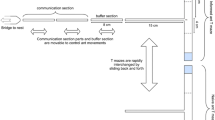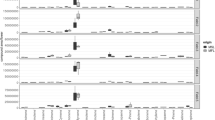Abstract
Melipona panamica foragers can deposit a scent beacon that influences the orientation of foragers near a food source. In misdirection experiments, newcomers (bees from the same colony as trained foragers) consistently preferred the feeder at which trained foragers had fed (training feeder) over an identical feeder at which bees had never fed (control feeder) even when the training feeder was placed at a site where experienced foragers had never foraged. Through similar misdirection experiments, the effective radius of the scent beacon was determined to be greater than 6 and less than 12 m. Foragers may deposit this beacon during a sequence of departure behaviors performed at the feeder. Prior to leaving the feeder with a load of sugar solution, bees tended to perform the following sequence of behaviors: (1) spinning, (2) grooming, (3) abdomen dragging, (4) excreting anal droplets, and (5) producing sounds, although not all behaviors were performed prior to each departure or at all sucrose concentrations (0.5–2.5 m). As sucrose concentration increased, the number of newcomers significantly increased, and the number of experienced foragers producing sounds and spinning on the feeder increased. The exact source of the scent beacon remains a mystery. However, three important sources have been excluded. When choosing between identical paired feeders, foragers were not attracted to the feeders with (1) anal droplets, (2) extracts of sucrose solution at which foragers had fed, or (3) mandibular gland extracts. They were indifferent to the first two preparations and exhibited only typical alarm behavior towards the mandibular gland (MG) extract: they oriented towards the feeder with MG extract but consistently landed on the feeder with no MG extract. Other authors have suggested that Melipona foragers deposit anal droplets to attract recruits, however the frequency of anal droplet production and the mass of anal droplets produced by M. panamica foragers are negatively correlated with sucrose concentration. Thus the scent beacon is evidently not deposited with anal droplets, infused into the feeder solution, or produced by mandibular glands.
Similar content being viewed by others
Author information
Authors and Affiliations
Additional information
Received: 2 September 1997 / Accepted after revision: 30 January 1998
Rights and permissions
About this article
Cite this article
Nieh, J. The role of a scent beacon in the communication of food location by the stingless bee, Melipona panamica . Behav Ecol Sociobiol 43, 47–58 (1998). https://doi.org/10.1007/s002650050465
Issue Date:
DOI: https://doi.org/10.1007/s002650050465




